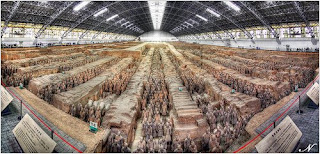Sound like your project? Well the project actually took place over 2,200 years ago, long before the triple constraints were even suggested. Qin Shi Huang was only 13 years old when he commissioned the building of his mausoleum, containing nearly 8,000 terracotta figures, including warriors, chariots and horses, civil servants, to protect him in the afterlife. This was after he completed the Great Wall of China. 38 years later, when the emperor died, the workers were sealed in the tomb with him so they would not give away any secrets.
It wasn't until 1974 that this 8th wonder of the ancient world was discovered. Today, less than 1,000 figures have been removed from the pit, and I had an opportunity to see this marvel last weekend at the Bowers Museum in Santa Ana. A joint project between the Bowers and the National Geographic Society, the largest collection of warriors ever seen outside of China will be on display until October 12th when the exhibit moves on to Houston and then the National Geographic Museum in Washington DC.
The exhibit is extremely well done and includes a representative sample of all but one group of figures -- the acrobats. It includes National Geographic renderings of what the inside of the tomb, as yet unexcavated, looks like and a scale model of the assembly line creating the figures. It is well worth the trip to see-- it really made me think about how such large projects were run before the project management profession.


No comments:
Post a Comment